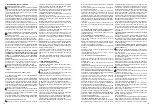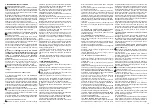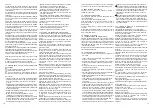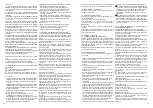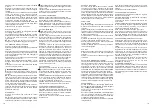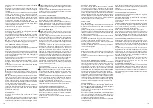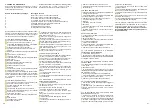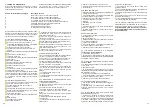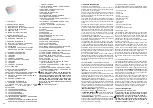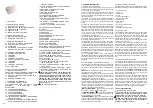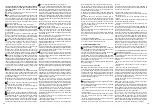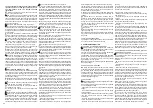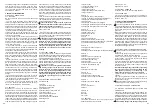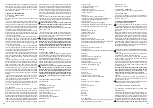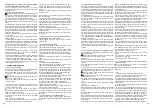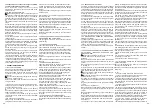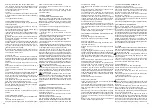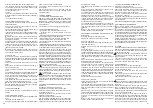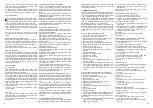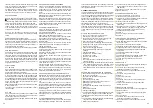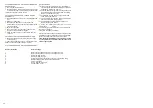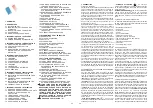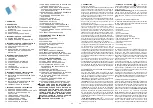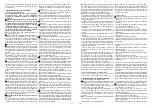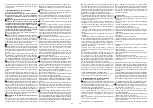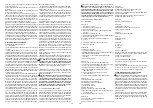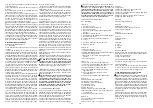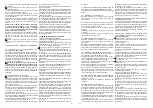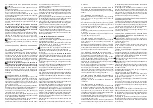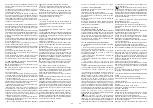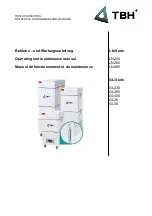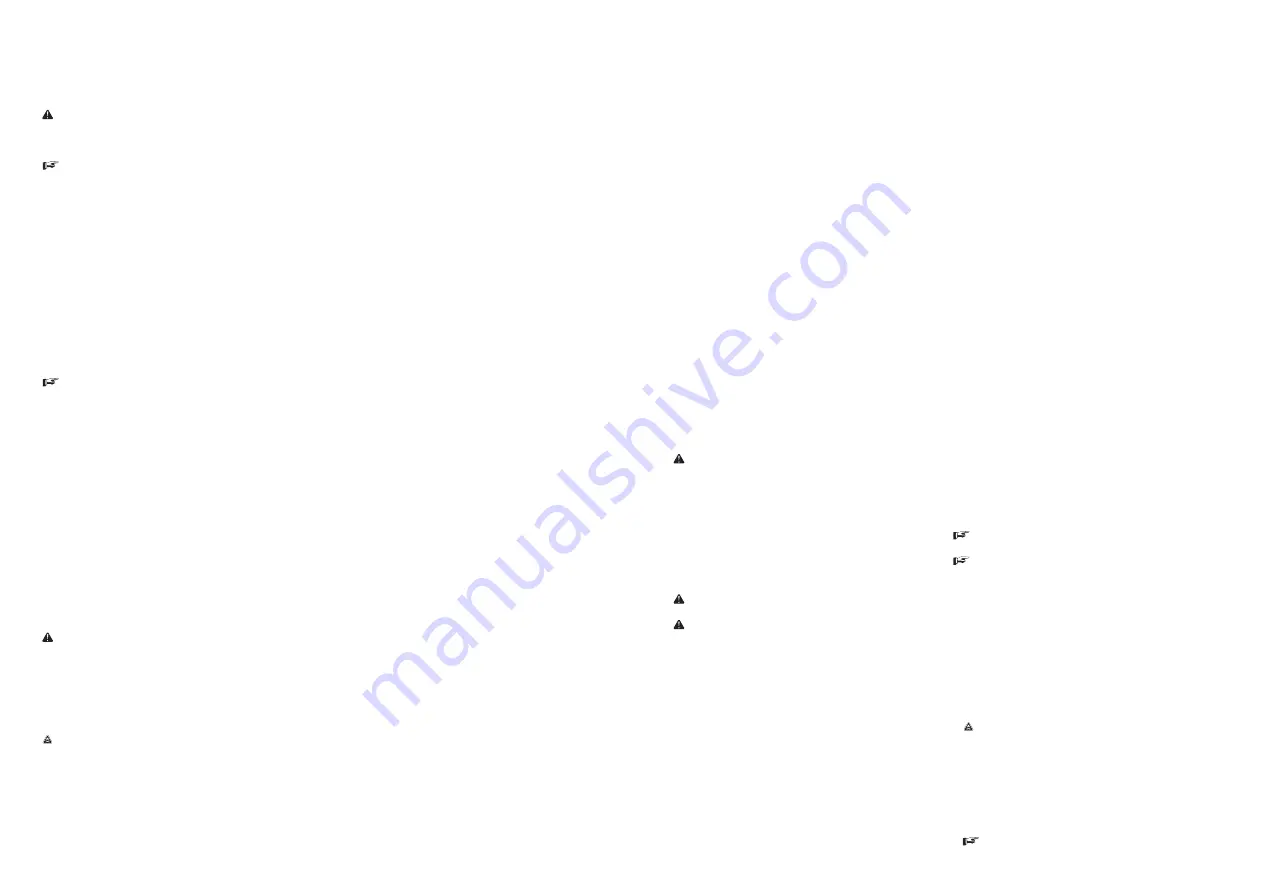
28
29
correspond, do not connect or charge the battery
contact the authorised service centre.
Once the battery charger has been correctly
programmed, follow the procedure described in the
specific section.
6.5 MACHINE PREPARATION
Before starting to work, wear non-slip shoes, gloves
and any other personal protection device indicated by
the supplier of the detergent used or considered
necessary based on the operating environment.
Do the following before starting to work. Refer to
the relative sections for a detailed description of these
steps:
Check the battery charge level and charge, if necessary.
Mount the brushes or scraper disks (with the abrasive
disks) that are suitable for the surface and work involved.
Mount the squeegee, check that it is solidly attached
and connected to the suction hose and that the drying
straps are not too worn.
Make sure that the recovery tank is empty. If not, empty
it completely.
Check and completely close the detergent solution
release control.
Fill the detergent solution tank with a mix of clean water
and non-foaming detergent in an adequate concentration
through the rear hole. Leave 7 cm between the mouth
of the plug and the level of the liquid.
To avoid risks, become familiar with the machine
movements, carrying out test runs on a large surface
without obstacles.
To obtain the best results in terms of cleaning and
equipment service life, you should do the following
simple but important operations:
- Identify the work area, moving all possible obstacles
out of the way; if the surface is very extensive, work in
contiguous and parallel rectangular areas.
- Choose a straight work trajectory and begin working
from the farthest area to avoid passing over areas that
have already been cleaned.
7. OPERATING INFORMATION
7.1 BATTERY CHARGING
Prepare and check the battery charge according to the
instructions provided in the specific section.
Detach the battery connector from the machine power
connector and connect it to the battery charger
connector.
Do not connect the battery charger to the scrubber-
driers main wiring connector.
Hold the connectors with the hands; do not pull them
using the cables.
If the machine is equipped with Pb-Acid batteries,
charge only in a well-ventilated area, lift the top tank
and open the battery plugs.
Follow the steps indicated in the battery
manufacturers operating and safety manual (see the
battery maintenance section).
If the machine is equipped with gel batteries
(maintenance free), follow the instructions indicated
here below.
If the machine is used regularly:
Always keep the batteries connected to the battery
charger when the machine is not being used.
If the machine is not used for extended time periods:
Charge the battery during the night after the last work
period, then disconnect the battery from the battery
charger.
Charge the battery during the night before using the
machine again.
Intermediate or incomplete charging while working
should be avoided.
If the machine is equipped with Pb-Acid batteries, use
a hydrometer to check the element liquid intensity on
a regular basis: if one or more elements are discharged
and the others fully charged, the battery has been
damaged and should be replaced or repaired (refer to
the battery service manual).
Close the element plugs and lower the top tank.
Hold the connectors with the hands; dont pull them
using the cables.
Reconnect the battery connector to the connector on
the machine.
7.2 SQUEEGEE AND SPLASH GUARD ASSEMBLY,
DISASSEMBLY AND ADJUSTMENT
The squeegee is the main component that ensures
perfect drying.
7.2.1 SQUEEGEE ASSEMBLY
Lower the lifting system to avoid having to keep the
body raised while completing connections.
Loosen the connection screws on the squeegee body.
Insert the body and the connection screws on the
crescent-shaped brackets of the oscillating support.
Fully tighten the squeegee screws to the oscillating
support.
Connect the adjustment screw pin to the squeegee
body.
Firmly insert the machine suction hose into the hole in
the body.
7.2.2 SQUEEGEE DISASSEMBLY
Lower the lifting system to avoid having to keep the
body raised while completing connections.
Disconnect the suction hose from the squeegee body.
Loosen the connections crews on the squeegee body.
Pull back the squeegee body to detach it from the
crescent-shaped brackets of the oscillating support.
7.2.3 SQUEEGEE STRAP ASSEMBLY
Position the metallic strips on the front strap and insert
the connection screws into the holes.
Bring the front strap and metallic strips with screws
closer to the squeegee body first from one side and
then from the other and centre the guide holes.
At this point add the rear strap, centering the holes
again on the projecting screws.
Tighten with bolts and connection screws starting from
one end up to the opposite side.
Its normal that the rear strap has to be extended to
centre the connection screws. This will bring it under
the correct tension to avoid folds on the floor and dry
correctly.
7.2.4 SQUEEGEE STRAP DISASSEMBLY
Loosen and remove the retaining screws and bolts on
the squeegee body. Release the straps from the retaining
strips.
7.2.5 SQUEEGEE ADJUSTMENT
The screw pin in the centre of the body is used to adjust
the squeegees slant with respect to the plane, according
to the machines longitudinal axis. The two handles on
the sides, connected to the rear wheels of the squeegee,
are used to adjust the slant with respect to the plane,
according to the axis perpendicular to the machines
operating direction.
To obtain a perfect adjustment, the rear strap, sliding
as it moves, bends in all points, forming an angle of
45° with the floor.
As the machine operates (advances), the knobs can
be used to adjust the slant of the straps: the slant
decreases as the knob is screwed in and increases as
it is unscrewed.
Squeegee drying must be uniform along the entire
drying line: moist sections on the sides indicate an
excessive extension of the central screw pin (tighten
it to improve the adjustment), while moist sections in
the centre indicate excessive contraction of the central
screw pin (unscrew it to improve the adjustment).
7.2.6 SPLASH GUARD ASSEMBLY, DISASSEMBLY
AND ADJUSTMENT
The splash guard is equipped with an innovative comb
connection system. To lower or lift the splash guard off
the ground, just pull, detach the splash guard and then
attach it, by pressing it at the required level.
Use can also use a rubber mallet to insert it firmly into
position.
7.3 ACCESSORY ASSEMBLY, DISASSEMBLY AND
ADJUSTMENT (BRUSHES, SCRAPERS AND
ABRASIVE DISKS)
Never use the machine if brushes or scrapers and
abrasive disks are not perfectly installed.
Assembly:
Make sure that the brush plate is raised; otherwise lift
it by following the instructions provided in the specific
section.
Make sure that the ignition key on the control panel is
in position 0.
Bring the brushes (or the guide disks equipped with
abrasive disks) near the connections, under the brush
plate; lower brush plate and turn on brush motor.
Do not allow the length of the rows of brushes to
become lower than 1 cm.
Do not allow the thickness of the abrasive disks to
become less than 1 cm.
Working with excessively worn brushes or excessively
thin abrasive disks may damage the machine and the
floor.
Regularly check the wear on these parts before starting
to work.
Disassembly or replacement:
Make sure that the brush plate is raised; otherwise lift
it by following the instructions provided in the specific
section.
Make sure that the ignition key on the control panel is
in position 0.
While holding the brushes (or the guide disks) with the
hands under the plate, turn them in the rotation direction
while lowering to release them from the guide plate.
Adjustment:
The brushes or the scraper disks (with the abrasive
disks) must always remain flat as they work on the floor,
otherwise it will not be possible to obtain the best results
and the parts will be subjected to irregular and therefore
premature wear.
Its difficult to adjust the brush unit. Contact a specialised
technician whenever the need arises and if you cannot
perform the adjustment correctly.
The brush unit cams must be adjusted in order to
change the support slant of the brush or the disks.
The cams are adjusted in the factory and need not be
adjusted the first time the machine is used.
Removing the safety guards on the plate support system
provides access to one/two screw(s) with a left cam
and to two screws (always with the cam system) on
the right side of the machine (with reference to the
seated operator).
Loosen the retaining screws to rotate the cams that
vary the brush unit slant with respect to the machines
longitudinal axis and the transverse axis.
On the right side the slant of the brush unit longitudinal
axis can be adjusted by using the rear cam. Only if
there are two cams on the left side is it also necessary
to use the rear one from this side to perform the
adjustment.
The right (front) and left (front if there are two) cams
are used to adjust the slant of the brush unit transverse
axis.
Do the following to correctly adjust the brush unit slant:
Completely lower the brush unit and allow the lowering
control on the panel to remain activated.
Remove the side safety guards.
Loosen all the retaining screws of the cams on both
sides.
Use the machine normally for about 20 minutes so as
to stabilise the brush unit.
Fully tighten the cam retaining screws.
7.4 FILLING AND DRAINING THE DETERGENT
SOLUTION TANK
The temperature of the water or the detergent
should never exceed 60°C.
Always empty the detergent solution tank before
filling it up.
To fill:
Remove the plug in the back of the machine.
Leave 7 cm between the mouth of the plug and the
liquid level. Do not fill beyond this point!
Add the required quantity of the chemical product,
considering the percentage indicated by the supplier,
with reference to the full tank capacity listed on the
product sheet.
Use only those products suitable for the floor and the
dirt to be removed.
The machine was designed to be used with non-
foaming and biodegradable detergents made specifically
for scrubber-driers. The use of other chemical products
(such as sodium hypochlorite, oxidisers, solvents or
hydrocarbons) may damage or destroy the machine.
Follow the safety regulations specified in the relative
section and indicated on the detergent container.
Contact the machine manufacturer to obtain a
complete list of available and suitable detergents.
Always add the detergent after filling the tank with
Summary of Contents for KF75B
Page 4: ...4 5 D C E F...
Page 5: ...4 5 D C E F...
Page 6: ...7 G H I L M 6...
Page 7: ...7 G H I L M 6...

